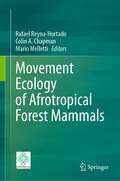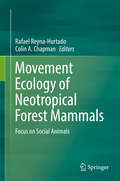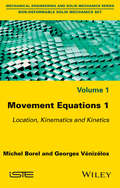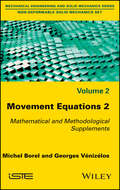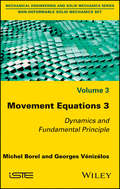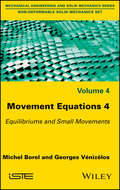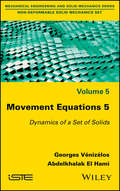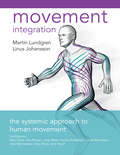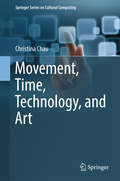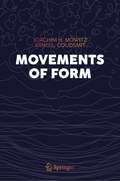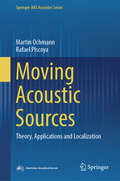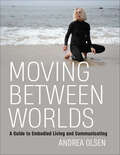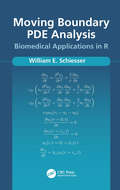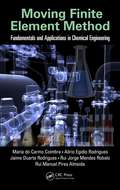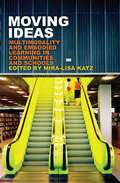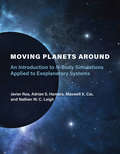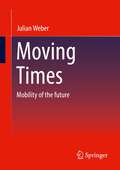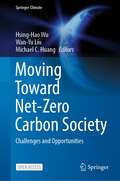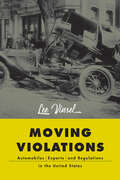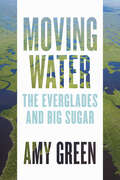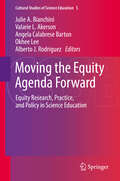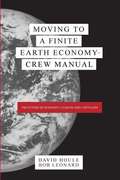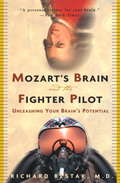- Table View
- List View
Movement Ecology of Afrotropical Forest Mammals
by Mario Melletti Colin A. Chapman Rafael Reyna-HurtadoThis book brings a unique perspective to animal movement studies because all studies come from African tropical environments where the great diversity, either biological and structurally (trees, shrubs, vines, epiphytes), present the animals with several options to fulfil their basic needs. These conditions have forced the evolution of unique movement patterns and ecological strategies. The book follows on our previous book “Movement Ecology of Neotropical Forest Mammals” but focuses on tropical African forests. Movement is an essential process in the life of all organisms. Animals move because they are looking for primary needs such as food, water, cover, mating and to avoid predators. Understanding the causes and consequences of animal movement is not an easy task for behavioural ecologists. Many animals are shy, move in secretive ways and are very sensible to human presence, therefore, studying the movements of mammals in tropical environments presents logistical and methodological challenges. However, researchers have recently started to be solved these challenges and exciting new information is emerging. In this book we are compiling a set of extraordinary studies where researchers have used new technology and the strongest methodological approaches to understand movement patterns in wild African forest mammals. This second book should inspire early career researchers to investigate wild mammal´s movements in some of the most amazing forest in the world: African tropical forests.
Movement Ecology of Neotropical Forest Mammals: Focus On Social Animals
by Colin A. Chapman Rafael Reyna-HurtadoThis book brings a unique perspective to animal movement studies because all cases came from tropical environments where the great diversity, either biological and structurally (trees, shrubs, vines, epiphytes), presents the animal with several options to fulfill its live requirements. These conditions have forced the evolution of unique movement patterns and ecological strategies. Movement is an essential process in the life of all organisms. Animals move because they are hungry, thirsty, to avoid being eaten, or because they want to find mates. Understanding the causes and consequences of animal movement is not an easy task for behavioural ecologists. Many animals are shy, move in secretive ways and are very sensible to human presence, therefore, studying the movements of mammals in tropical environments present logistical and methodological challenges that have recently started to be solved by ecologist around the world. In this book we are compiling a set of extraordinary cases where researchers have used some of the modern technology and the strongest methodological approaches to understand movement patterns in wild tropical mammals. We hope this book will inspire and encourage young researchers to investigate wild mammal´s movements in some of the amazing tropical environments of the world.
Movement Equations 1: Location, Kinematics and Kinetics
by Georges Vénizélos Michel BorelThe set of books on Mechanical Engineering and Solid Mechanics, of which this book is the first volume, is an essential tool for those looking to develop a rigorous knowledge of the discipline, whether students, professionals (in search of an approach to a problem they are dealing with), or anyone else interested. This volume deals with the elements required for establishing the equations of motion when dealing with solid bodies. Chapter 1 focuses on the systems of reference used to locate solid bodies relative to the observer, and demonstrates how to describe their position, orientation, and evolution during their motion. Chapter 2 introduces descriptors of motion such as velocity and acceleration, and develops the concept of torsor notation in relation to these descriptors. Finally, Chapter 3 concerns the notions of mass and inertia, as well as the kinetic torsor and dynamic torsor which consolidate the kinematic and kinetic aspects in a single concept. The set of books on Mechanical Engineering and Solid Mechanics, of which this book is the first volume, is an essential tool for those looking to develop a rigorous knowledge of the discipline, whether students, professionals (in search of an approach to a problem they are dealing with), or anyone else interested. This volume deals with the elements required for establishing the equations of motion when dealing with solid bodies. Chapter 1 focuses on the systems of reference used to locate solid bodies relative to the observer, and demonstrates how to describe their position, orientation, and evolution during their motion. Chapter 2 introduces descriptors of motion such as velocity and acceleration, and develops the concept of torsor notation in relation to these descriptors. Finally, Chapter 3 concerns the notions of mass and inertia, as well as the kinetic torsor and dynamic torsor which consolidate the kinematic and kinetic aspects in a single concept.
Movement Equations 2: Mathematical and Methodological Supplements
by Georges Vénizélos Michel BorelThe formalism processing of unbuckled solids mechanics involves several mathematical tools which are to be mastered at the same time. This volume collects the main points which take place in the course of the formalism, so that the user immediately finds what he needs without looking for it. Furthermore, the book contains a methodological formulary to guide the user in his approach.
Movement Equations 3: Dynamics and Fundamental Principle
by Georges Vénizélos Michel BorelThis volume is the focal point of the work undertaken in the previous volumes of this set of books: the statement of the fundamental principle of the dynamics whose implementation, according to two paths whose choice depends on the problem to be treated, leads to equations of motion. In order to achieve this, it is treated first of all in the context of solids in their environment, as a prerequisite for the formulation of the fundamental principle. Then, in addition to its use in some exercises, the approach is illustrated by three particular cases. The first is an example where it is developed end-to-end and addresses the two approaches that lead to the equations of motion. The two other examples deal with two classical but important subjects, the movement of the Earth according to the hypotheses that can be stated about it, and Foucault’s pendulum.
Movement Equations 4: Equilibriums and Small Movements
by Michel Borel Georges VenizelosAn important instance of the application of unbuckled solid mechanics is that of its stability and small movements from this situation. The problem expressing goes through the linearization of the movement equations set up in the 3rd volume of this treaty, by their limited development. This book gives and develops the process which leads to the differential linear equations expressing this kind of movement and allowing the study of the equilibrium and the stability of an unbuckled solid.
Movement Equations 5: Dynamics of a Set of Solids
by Georges Vénizélos Abdelkhalak El HamiThe final volume in the Non-deformable Solid Mechanics set, Movement Equations 5 deals with the dynamics of sets of solids. This volume provides the appropriate mathematical tools (torsor calculus and matrix calculus) to obtain and solve the equations of motion for a chain of solids. These equations are then used to acquire the information necessary for the design of mechanical systems. Also examined are the vibratory behavior of continuous (deformable) systems, rigid and deformable solids, and sets of several solids. The book concludes with a study of the response of an excited system as a function of the excitation frequency. Accompanied by detailed examples, this book is aimed primarily at students, but would also serve as a valuable support for working engineers and teacher-researchers.
Movement Integration: The Systemic Approach to Human Movement
by Martin Lundgren Linus JohanssonA paradigm-shifting, integrative approach to understanding body movement.The ability to move with efficiency and agility has been an essential component to our evolution and survival as a species. It has enabled us to find food, fight threats, flee danger, and flourish both individually and collectively. Our body's intricate network of bones, muscles, tissues, and organs moves with great complexity. While traditional anatomy has relied on a reductionist frame for understanding these mechanisms in isolation, the contributors to Movement Integration take a more systemic, integrative approach. Ensomatosy is a new paradigm for comprehending movement from the perspective of the body's entirety. The body's many systems are understood as synchronized both internally and externally. Drawing on expertise in physiotherapy, somatics, sports science, Rolfing, myofascial therapy, craniosacral therapy, Pilates, and yoga, the authors assert that a more comprehensive understanding of movement is key to restoring the body's natural ability to move fluidly and painlessly. With over 150 images, the Color Illustration Model of Relative Movement provides a visual tool for understanding how joints interact with surrounding structures (rather than in isolation). This is an ideal book for physiotherapists, massage therapists, structural integrators, coaches, as well as yoga and Pilates instructors.
Movement of Acoustic Energy in the Ocean
by Vladimir A. ShchurovThis book highlights the advantages of the vector-phase method in underwater acoustic measurements and presents results of theoretical and experimental studies of the deep open ocean and shallow sea based on vector-phase representations. Based on the physical phenomena discovered and compensation of counter streams of energy and vortices of the acoustic intensity vector, processes of transmitting acoustic energy of a tonal signal in the real ocean are described. The book also discusses the development of advanced detection tools based on vector-phase sonar. This book provides useful content for professionals and researchers working in various fields of applied underwater acoustics.
Movement, Time, Technology, and Art
by Christina ChauThis book explores the ways in which artists use technology to create different perceptions of time in art in order to reflect on contemporary relationships to technology. By considering the links between technology, movement and contemporary art, the book explores changing relationship between temporality in art, art history, media art theory, modernity, contemporary art, and digital art. This book challenges the dominant view that kinetic art is an antiquated artistic experiment and considers the changing perception of kinetic art by focusing on exhibitions and institutions that have recently challenged the notion of kinetic art as a marginalised and forgotten artistic experiment with mechanical media. This is achieved by deconstructing Frank Popper's argument that kinetic art is a precursor to subsequent explorations in the intersections between art, science and technology. Rather than pandering to the prevailing art historical assumption that kinetic sculpture is merely a precursor to art in a digital culture, the book proposes that perhaps kineticism succeeded too well, where movement has become a ubiquitous element of the aesthetic of contemporary art. If, as Boris Groys has recently suggested, installation has become the dominant mode of art in the contemporary age, then movement in real time with the viewer is used to aestheticise and explore the facets of our peculiar time.
Movements of Form (Vision, Illusion and Perception #6)
by Arno L. Goudsmit Joachim H. MowitzThis book offers a thought-provoking exploration of dynamic geometry and its connections to self-reference and theoretical biology. The authors explore how a self-referential boundary can be translated into remarkable relations between expanding geometrical forms, with a particular focus on triangles and circles.The essence of this work lies in revealing not only how these forms expand and interact with others but also how their interactions lead to closed loops of definitions between processes, where triangles and circles reciprocally define one another. These unique geometrical relations offer fresh perspectives on the interaction and emergence of forms. Through the introduction of time and a fixed velocity of expansions, a rich tapestry of encounters and coalescences unfolds, pushing beyond the boundaries of traditional insights on context dependence and state transitions of systems.These captivating movements elude prediction other than by numerical approximation within unpredictable durations. Unlike cellular automata, they defy stepwise progression on a predefined grid, presenting themselves as unprogrammable construction processes that leave readers in awe of their unexpected elegance.This book is essential reading for researchers and students in theoretical biology seeking to deepen their understanding of the intersections of geometry and systems theory and seeking to gain new insights into the processes that underlie the origination of complexity."What is unique to the authors' attempt is to shed a new light on extending the notion of cohesive interaction so as to make it applicable even to biology at large without offending the established physics so far. To the best of my knowledge, their work has been the first attempt of this kind in explicating the intricate relationship between geometric topology of the network and the realizable temporal cohesion to be observed widely in biology." (Professor Koichiro Matsuno, 1st foreword to this book) "I am delighted that the authors use Robert Rosen's (M,R)-systems — impredicative networks that are inherently geometrical — to illustrate (see Chapter 4 of this book) their self-referential systems of geometrical expansions." (dr. Aloisius Louie, 2nd foreword to this book)
Moving Acoustic Sources: Theory, Applications and Localization (Springer-AAS Acoustics Series)
by Martin Ochmann Rafael PiscoyaThis book highlights the mathematical, physical, and technical properties of moving acoustic sources. Authors consider point sources and infinite or finite line sources moving along various curves in three-dimensional space. After studying the general theory of such sources, the frequency spectrum and the associated Doppler shift are derived explicitly for different trajectories. The sound radiation in half-spaces with a locally reacting and homogeneous ground is investigated in detail based on the knowledge of closed-form solutions for the stationary impulse response. An important field of application is the localization of moving sources. Among other approaches, an equivalent source method in the time domain is used to develop an effective source localisation method. Important practical applications are explored with these techniques, e.g. the detection of noise sources from trains and airplanes. The research results published in this book are mainly obtained within the three-year project “Localization and identification of moving noise sources” funded by the German Research Foundation.
Moving Between Worlds: A Guide to Embodied Living and Communicating
by Andrea OlsenCommunication is a fundamental human activity, and as much as 90% of all communication is non-verbal. Yet awareness of embodied intelligence in communication is rare. This book is the fourth in a series by interdisciplinary educator Andrea Olsen focused on embodiment. Through the exercises and readings in this book, we can deepen our relationship to ourselves and others and improve our communication skills, moving between worlds: inner and outer; self and other; self and Earth. Each of the thirty-one chapters combines factual information, personal anecdotes, and somatic excursions, inviting the reader to explore multiple learning styles and lenses for finding balance in a more-than-human world. This guidebook is a valuable resource for anyone seeking practical tools for living and communicating with more ease and clarity.
Moving Boundary PDE Analysis: Biomedical Applications in R
by William SchiesserMathematical models stated as systems of partial differential equations (PDEs) are broadly used in biology, chemistry, physics and medicine (physiology). These models describe the spatial and temporial variations of the problem system dependent variables, such as temperature, chemical and biochemical concentrations and cell densities, as a function of space and time (spatiotemporal distributions). For a complete PDE model, initial conditions (ICs) specifying how the problem system starts and boundary conditions (BCs) specifying how the system is defined at its spatial boundaries, must also be included for a well-posed PDE model. In this book, PDE models are considered for which the physical boundaries move with time. For example, as a tumor grows, its boundary moves outward. In atherosclerosis, the plaque formation on the arterial wall moves inward, thereby restricting blood flow with serious consequences such as stroke and myocardial infarction (heart attack). These two examples are considered as applications of the reported moving boundary PDE (MBPDE) numerical method (algorithm). The method is programmed in a set of documented routines coded in R, a quality, open-source scientific programming system. The routines are provided as a download so that the reader/analyst/researcher can use MFPDE models without having to first study numerical methods and computer programming.
Moving Finite Element Method: Fundamentals and Applications in Chemical Engineering
by Rui Manuel Almeida Maria do Coimbra Alirio Egidio Rodrigues Jaime Duarte Rodrigues Rui Jorge RobaloThis book focuses on process simulation in chemical engineering with a numerical algorithm based on the moving finite element method (MFEM). It offers new tools and approaches for modeling and simulating time-dependent problems with moving fronts and with moving boundaries described by time-dependent convection-reaction-diffusion partial differential equations in one or two-dimensional space domains. It provides a comprehensive account of the development of the moving finite element method, describing and analyzing the theoretical and practical aspects of the MFEM for models in 1D, 1D+1d, and 2D space domains. Mathematical models are universal, and the book reviews successful applications of MFEM to solve engineering problems. It covers a broad range of application algorithm to engineering problems, namely on separation and reaction processes presenting and discussing relevant numerical applications of the moving finite element method derived from real-world process simulations.
Moving Ideas: Multimodality And Embodied Learning In Communities And Schools (New Literacies And Digital Epistemologies #65)
by Mira-Lisa KatzWhat does it look and feel like to communicate, create, compose, comprehend, teach, and learn with our bodies? Reaching beyond existing scholarship on multimodality and literacies, Moving Ideas expands our capacity to understand the embodied dimensions of learning and stretches our repertoires for more artfully describing them. Wresting language away from its historically privileged place at the center of social science research and practice, this collection examines the strategic layering across semiotic modes, challenging educators and researchers to revisit many of our most elemental assumptions about communication, learning, and development. The corporeal pedagogies these authors describe illuminate a powerful kind of learning that we know far too little about; in this age of accountability and high-stakes testing, failing to pay adequate attention to the promise of multimodality means forfeiting significant resources that could be used to innovatively engage people of all ages in education broadly conceived.
Moving Planets Around: An Introduction to N-Body Simulations Applied to Exoplanetary Systems
by Javier Roa Adrian S. Hamers MAXWELL X. CAI Nathan W. LeighAn introduction to the laws of celestial mechanics and a step-by-step guide to developing software for direct use in astrophysics research.This book offers both an introduction to the laws of celestial mechanics and a step-by-step guide to developing software for direct use in astrophysics research. It bridges the gap between conventional textbooks, which present a rigorous and exhaustive exposition of theoretical concepts, and applying the theory to tackle real experiments. The text is written engagingly in dialogue form, presenting the research journey of the fictional Alice, Bob, and Professor Starmover. Moving Planets Around not only educates students on the laws of Newtonian gravity, it also provides all that they need to start writing their own software, from scratch, for simulating the dynamical evolution of planets and exoplanets, stars, or other heavenly bodies.
Moving Times: Mobility of the future
by Julian WeberWill we really soon no longer be sitting behind the wheel of our own car, but will only be taken to our destination by driverless electric taxis? Should cities introduce car sharing? What role will electric scooters, cable cars or man-carrying drones play in the mobility systems of major cities? This book finally explains in a generally understandable way what is really behind buzzwords such as electric mobility, autonomous driving, digitalization and mobility services such as car sharing or ride-hailing, how far advanced these technologies are today, and above all in what relationships and dependencies they are to each other. In addition to the technical aspects, the legislative and social trends are also considered, which are important framework conditions that will have a decisive influence on the mobility of the future. From the contents - Mobility needs: Who wants to go where, when and why - and how will this change in the future? - Technological trends: electromobility, digitalization, autonomous driving - what will the vehicles of the future be capable of? - Car sharing, ride-hailing, e-scooters or public transport: What alternatives to the private car will there be in the future? - Politics and society: How will the framework conditions for mobility develop in the future? - Mobility in transition: What should we do to prepare for the future?
Moving Toward Net-Zero Carbon Society: Challenges and Opportunities (Springer Climate)
by Hsing-Hao Wu Wan-Yu Liu Michael C. HuangThis open access book explores various issues concerning the net-zero emission achievement, ranging from carbon pricing, carbon trade schemes, energy transition, ecological conservation, and carbon sinks, as well as the economic and social impacts of introducing carbon neutral policies in the Asia-Pacific region. The extreme flooding and drought problems, crop yield problems, and habitat changes brought about by climate change have seriously threatened the ecosystem and human survival, forcing people to rethink environmental management policies and limits on economic development. In the post-COVID-10 era, it is indispensable to adopt a more proactive climate change adaptation policy and establish bilateral cooperation with international partners who value climate change. 2021 is a critical year, and the leaders of major industrial countries at the recently concluded G7 meeting jointly stated the common objective seeking the establishment of carbon-neutral international community by the mid of the century. Major carbon-emitting countries or entities such as the European Union, US, Japan, Korea, China, and India have proposed specific timetables for net-zero carbon emissions and carbon neutrality before or at the COP26. Policy-makers around the world would also work closely with scientists, experts, and enterprises seeking appropriate policy instruments such as the development of carbon tax, carbon pricing, carbon sinks, global or regional carbon emission trade schemes, energy transitions, and other carbon-neutral policies moving toward net-zero emission society by the mid of the century. At a time when carbon pricing policies are being formulated, climate change related laws and policies will reshape the global governance and industrial layout during the period of 2021–-2030, and it is critical to move toward energy and industrial transformation, ecological conservation, and sustainable agricultural development.
Moving Violations: Automobiles, Experts, and Regulations in the United States (Hagley Library Studies in Business, Technology, and Politics)
by Lee VinselThe first comprehensive history of auto regulation in the United States.Regulation has shaped the evolution of the automobile from the beginning. In Moving Violations, Lee Vinsel shows that, contrary to popular opinion, these restrictions have not hindered technological change. Rather, by drawing together communities of scientific and technical experts, auto regulations have actually fostered innovation.Vinsel tracks the history of American auto regulation from the era of horseless carriages and the first, faltering efforts to establish speed limits in cities to recent experiments with self-driving cars. He examines how the government has tried to address car-related problems, from accidents to air pollution, and demonstrates that automotive safety, emissions, and fuel economy have all improved massively over time. Touching on fuel economy standards, the rise of traffic laws, the birth of drivers' education classes, and the science of distraction, he also describes how the government's changing activities have reshaped the automobile and its drivers, as well as the country's entire system of roadways and supporting technologies, including traffic lights and gas pumps. Moving Violations examines how policymakers, elected officials, consumer advocates, environmentalists, and other interested parties wrestled to control the negative aspects of American car culture while attempting to preserve what they saw as its positive contributions to society. Written in a clear, approachable, and jargon-free voice, Moving Violations will appeal to makers and analysts of policy, historians of science, technology, business, and the environment, and any readers interested in the history of cars and government.
Moving Water: The Everglades and Big Sugar
by Amy GreenA riveting story of environmental disaster and political intrigue, Moving Water exposes how Florida's clean water is threatened by dirty power players and the sugar cane industry.Only a century ago, nearly all of South Florida was under water. The Everglades, one of the largest wetlands in the world, was a watery arc extending over 3 million acres. Today, that wetland ecosystem is half of its former self, supplanted by housing for the region's exploding population and over 700,000 acres of crops, including the nation's largest supply of sugar cane. Countless canals, dams, and pump stations keep the trickle flowing, but rarely address the cascade of environmental consequences, including dangerous threats to a crucial drinking water source for a full third of Florida's residents. In Moving Water, environmental journalist Amy Green explores the story of unlikely conservation heroes George and Mary Barley, wealthy real estate developers and champions of the Everglades, whose complicated legacy spans from fisheries in Florida Bay to the political worlds of Tallahassee and Washington. At the center of their surprising saga is the establishment and evolution of the Comprehensive Everglades Restoration Plan (CERP), a $17 billion taxpayer-funded initiative aimed at reclaiming this vital ecosystem. Green explains that, like the meandering River of Grass, the progress of CERP rarely runs straight, especially when it comes up against the fierce efforts of sugar-growing interests, or "Big Sugar," to obstruct the cleanup of fertilizer runoff wreaking havoc with restoration. This engrossing exposé tackles some of the most important issues of our time: Is it possible to save a complex ecosystem such as the Everglades—or, once degraded, are such ecological wonders gone forever? What kind of commitments—economic, scientific, and social—will it take to rescue our vulnerable natural resources? What influences do special interests wield in our everyday lives, and what does it take to push real reform through our democracy? A must-read for anyone fascinated by stories of political intrigue and the work of environmental crusaders like Erin Brockovich, as well as anyone who cares about the future of Florida, this book reveals why the Everglades serve as a model—and a warning—for environmental restoration efforts worldwide.
Moving the Equity Agenda Forward
by Angela Calabrese Barton Okhee Lee Julie A. Bianchini Valarie L. Akerson Alberto J. RodriguezThis volume takes on the vital tasks of celebrating, challenging, and attempting to move forward our understanding of equity and diversity in science education. Organized thematically, the book explores five key areas of science education equity research: science education policy; globalization; context and culture; discourse, language and identity; and leadership and social networking. Chapter authors -- emerging to established US science education scholars -- present their latest research on how to make science interesting and accessible to all students. The volume includes international voices as well: Scholars from around the world crafted responses to each section. Together, authors and respondents attempt to refine our methods for examining equity issues across classrooms, schools, and policies, and deepen our understanding of ways to promote equity and acknowledge diversity in science classrooms. Moving the Equity Agenda Forward is endorsed by NARST: A Worldwide Organization for Improving Science Teaching and Learning Through Research. The volume gains authority from the fact that it was edited by one current and four former chairs of NARST's Equity and Ethics Committee.
Moving to a Finite Earth Economy Crew Manual: The Complete Trilogy
by David Houle; Bob Leonard“Moving to a Finite Earth Economy – Crew Manual” is a book that, in an all-inclusive way, outlines what humanity needs to do to successfully address the root cause of our climate emergency. <p><p> When it comes to climate change, the past doesn't equal the future. What is happening now has never occurred during humanity’s time on Earth. Who better than a futurist to address this? Futurist David Houle immersed himself in all facets of global warming and climate change over the past four years. He spent two years researching, writing and co-authoring "This Spaceship Earth". What he learned in that process prompted Houle to cofound a global nonprofit: thispaceshipearth.org. <p> As a result, Houle was invited to speak at the EPA, at the NASA Goddard Space Flight Center, and at numerous other environmental gatherings and conferences around the globe. Houle wrote, "It is my fundamental responsibility as a futurist to be right about the future, and to offer possible suggestions on how best to navigate it. This book does just that for the existential threat that is climate change." <p> This is NOT another long, dense, difficult to read book arguing about whether climate change is real. It accepts that it is, that it is caused by us, and sets forth what we must do. The need for URGENCY is reinforced throughout the book. Houle has no qualms about stating the facts as he sees them. We have until 2030 and we haven't a minute to waste. <p> Houle and his co-author, Bob Leonard, make the case for humanity to move to a Finite Earth Economy as fully as possible by 2030. They discuss the new metrics and technologies needed to advance from here to there. Houle and Leonard provide clarity as to what must be done at all levels of humanity from global corporations and nation state governments all the way to individuals. This book also deals with two major issues rarely covered in climate change literature: population management and strategic retreat. This book answers the question: “What can we do to successfully prevail over climate change?” <p> The time for dealing with denial is over. Now is the time to focus on solutions… solutions that impact every facet of modern life. For those of you who are ready to do something about climate change, this book will help you walk your talk. “Moving to a Finite Earth Economy” is a clear-eyed look at what’s coming, and what we can do about it.
Mozart's Brain and the Fighter Pilot: Unleashing Your Brain's Potential
by Richard RestakIn Mozart's Brain and the Fighter Pilot, eminent neuropsychiatrist and bestselling author Richard Restak, M.D., combines the latest research in neurology and psychology to show us how to get our brain up to speed for managing every aspect of our busy lives.
Mr Tompkins in Paperback
by George GamowSince his first appearance over sixty years ago, Mr Tompkins has become known and loved by many thousands of readers as the bank clerk whose fantastic dreams and adventures lead him into a world inside the atom. George Gamow's classic provides a delightful explanation of the central concepts in modern physics, from atomic structure to relativity, and quantum theory to fusion and fission. Roger Penrose's foreword introduces Mr Tompkins to a new generation of readers, and reviews his adventures in light of recent developments in physics.
